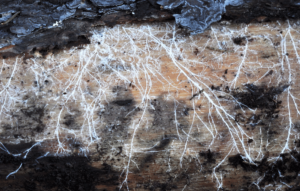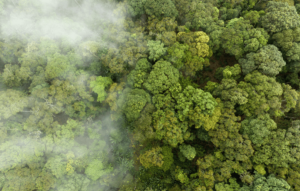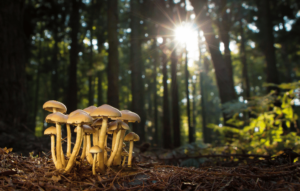In the face of growing environmental challenges, efforts to restore ecosystems are more critical than ever. Among the many tools at humanity’s disposal, one of nature’s most powerful – yet often overlooked – forces are mushrooms. More than just a culinary delight, mushrooms and their intricate networks of mycelium are pivotal players in ecological restoration.
From soil health to carbon sequestration and even pollution cleanup, fungi can play an integral role in creating a sustainable future. In this blog, we’ll explore how mushrooms can, and already do, contribute to restoring ecosystems and how their presence can offer promising solutions for environmental sustainability.
The Role of Mycelium in Ecosystem Restoration
At the heart of a mushroom’s ecological power lies mycelium – an underground network of fungal threads that essentially act as nature’s connective tissue. Often referred to as the “wood wide web,” mycelium networks serve as an invisible infrastructure, weaving through soil and plant roots to foster communication, share resources, and nurture entire ecosystems.
network of fungal threads that essentially act as nature’s connective tissue. Often referred to as the “wood wide web,” mycelium networks serve as an invisible infrastructure, weaving through soil and plant roots to foster communication, share resources, and nurture entire ecosystems.
- Nutrient Cycling and Soil Regeneration: Mycelium breaks down complex organic matter, returning essential nutrients to the soil. This process not only helps decompose fallen trees and leaves but also enhances the soil’s fertility. Through this nutrient cycling, mushrooms enable plants to thrive, creating healthier ecosystems.
- Water Distribution: Mycelium networks facilitate the transportation of water between plant roots. In drought-prone or nutrient-poor environments, this ability is crucial for plant survival. By connecting different plant species, mycelium promotes biodiversity and resilience within ecosystems.
- Symbiotic Relationships: Mycorrhizal fungi, a type of mycelium, form symbiotic partnerships with plant roots. In exchange for carbohydrates produced by the plants, these fungi enhance the plants’ ability to absorb water and nutrients, particularly phosphorus. This relationship not only supports plant health but also accelerates the regeneration of forests, grasslands, and other ecosystems after disturbances such as fires or logging.
Mushrooms and Bioremediation
One of the most remarkable abilities of mushrooms is their capacity to break down pollutants. This process, known as bioremediation, uses fungi to decompose toxic substances that would otherwise linger in the environment for decades.
- Breaking Down Pollutants: Certain fungi are capable of metabolizing hazardous compounds, including petroleum, heavy metals, and plastics. In polluted environments, these fungi can clean up contaminated soil and water, offering a natural alternative to chemical remediation methods. For instance, fungi like Pleurotus ostreatus (the oyster mushroom) can break down oil spills, while others can reduce toxic heavy metals to safer forms.
- Combatting Plastic Waste: With plastic pollution at an all-time high, mushrooms are emerging as a potential solution. Some species can degrade polyethylene and other types of plastic, reducing their environmental impact. By incorporating these fungi into waste management strategies, we could significantly reduce the volume of plastic waste in landfills and oceans.
- Mycoremediation of Pesticides and Herbicides: Fungi also have the ability to detoxify agricultural chemicals that accumulate in soil. As agricultural runoff continues to pollute waterways, using mushrooms in contaminated areas could mitigate the long-term damage caused by pesticides and herbicides.
Mushrooms and Carbon Sequestration
In the battle against climate change, mushrooms play a critical role in carbon sequestration – the process of capturing and storing carbon dioxide (CO2) from the atmosphere. Forest ecosystems, in particular, rely on fungi to trap carbon in soil, reducing the amount of CO2 released into the air.
- Soil Carbon Storage: Mushrooms and their mycelium help stabilize organic carbon in soils, making it less likely to escape as CO2. When forests are healthy and full of mycelium-rich soil, they act as carbon sinks, storing vast amounts of carbon that would otherwise contribute to global warming.
- The Fungi-Tree Partnership: Trees rely heavily on mycorrhizal fungi to absorb nutrients, and in return, the fungi store carbon underground. This partnership enhances the capacity of forests to sequester carbon. Moreover, research suggests that the more diverse and extensive the fungal networks, the more efficient the carbon storage process.

Mushrooms in Sustainable Agriculture
Beyond their role in wild ecosystems, mushrooms can also enhance agricultural sustainability. Regenerative agriculture, which seeks to restore soil health and biodiversity, benefits greatly from the inclusion of fungi.
- Soil Health and Crop Yields: Fungi improve soil structure, making it more
 resistant to erosion and more capable of holding water. This is especially important in areas prone to desertification. By integrating mycorrhizal fungi into farming practices, farmers can increase crop yields without relying on synthetic fertilizers.
resistant to erosion and more capable of holding water. This is especially important in areas prone to desertification. By integrating mycorrhizal fungi into farming practices, farmers can increase crop yields without relying on synthetic fertilizers. - Pest Control: Certain fungi, like Beauveria bassiana, can act as natural pesticides, targeting harmful insects while leaving beneficial organisms untouched. This reduces the need for chemical pesticides, which can harm both the environment and human health.
- Sustainable Food Production: Edible mushrooms like shiitake, oyster, and button mushrooms are not only nutritious but can also be grown in sustainable ways. Mushroom farming uses significantly less land, water, and energy than traditional livestock farming, making it a valuable food source for a growing population.
Restoring Forests with Fungi
Forests are home to the largest carbon sinks on the planet, and mushrooms are essential for forest health and restoration. Fungi decompose dead plant material, releasing nutrients back into the soil and promoting new growth.
- Forest Regeneration: After wildfires, logging, or other disturbances, mushrooms are often the first organisms to appear, jump-starting the regeneration process. Species like Morchella (morels) thrive in post-fire environments, preparing the soil for the return of trees and plants.

- Biodiversity Support: Healthy forests depend on fungal diversity. When reforestation efforts include inoculating the soil with a variety of fungal species, the success of tree planting and overall biodiversity improves. Fungi help trees grow more resiliently, making forests less vulnerable to future disturbances.
Mushrooms and a Sustainable Future
As we continue to search for ways to mitigate environmental damage, mushrooms offer a promising and underutilized avenue for restoring ecosystems and promoting sustainability. Their ability to sequester carbon, degrade pollutants, and regenerate soil positions them as a critical component of our environmental toolkit.
- Circular Economy Potential: Mushrooms could play a significant role in developing a circular economy, where waste materials are recycled and repurposed rather than discarded. Fungi’s ability to break down organic waste, plastics, and other materials aligns perfectly with this model.
- Food Security and Health: In addition to their ecological benefits, mushrooms are a valuable food source that can be grown sustainably in a variety of environments, contributing to food security and reducing the environmental footprint of food production.

Final Thoughts
Mushrooms are so much more than just a food source – they are nature’s secret weapon in the fight to restore ecosystems and build a sustainable future. From cleaning up polluted landscapes to sequestering carbon and supporting regenerative agriculture, fungi hold immense potential for ecological healing. By embracing the power of mushrooms, we can harness nature’s own solutions to some of the world’s most pressing environmental challenges, helping to build a healthier planet for present and future generations.
power of mushrooms, we can harness nature’s own solutions to some of the world’s most pressing environmental challenges, helping to build a healthier planet for present and future generations.


 resistant to erosion and more capable of holding water. This is especially important in areas prone to desertification. By integrating mycorrhizal fungi into farming practices, farmers can increase crop yields without relying on synthetic fertilizers.
resistant to erosion and more capable of holding water. This is especially important in areas prone to desertification. By integrating mycorrhizal fungi into farming practices, farmers can increase crop yields without relying on synthetic fertilizers.






